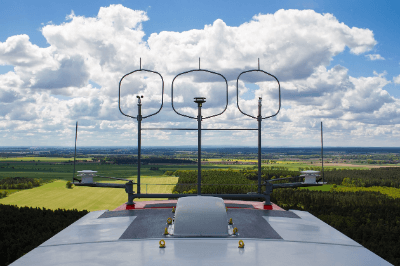What Is an Ultrasonic Anemometer?
 An ultrasonic anemometer is a type of anemometer. An anemometer is a device that measures the direction and velocity of wind in order to measure the strength of wind in the atmosphere and wind coming out of exhaust vents.
An ultrasonic anemometer is a type of anemometer. An anemometer is a device that measures the direction and velocity of wind in order to measure the strength of wind in the atmosphere and wind coming out of exhaust vents.
There are several methods of anemometers, but the main feature of ultrasonic anemometers is that they can make three-dimensional observations, rather than two-dimensional, like other anemometers. In other words, it is possible to observe the vertical component of the wind, such as upwind and downwind.
Another feature is that the anemometer does not have a mechanically movable structure, so there is little risk of damage, even in strong winds, and it can easily follow transient changes.
Uses of Ultrasonic Anemometers
Anemometers range from those that are resistant to rain and snow for outdoor use to those that are suitable for indoor use for environmental surveys in clean rooms and manufacturing sites where precision is required. Among them, ultrasonic anemometers are often used in the following applications.
1. Indoor Use
- Confirmation of changes in airflow in clean rooms
- Liquid crystal panels
- LED manufacturing lines
- Monitoring in living environments and refrigerators
2. Examples of Outdoor Use
- Atmospheric dispersion observation construction
- Safety management in civil engineering
- Bottom layer meteorological and polar weather measurements
- Safe operation of transportation
Principle of Ultrasonic Anemometers
Ultrasonic anemometers measure sound velocity by the amount of change in sound velocity caused by wind speed. The reason that ultrasonic waves can measure wind speed is that when sound waves propagate in a windy condition in space, i.e., in an atmosphere in motion, the sound is swept away by the wind, and the time it takes to propagate changes.
Specifically, the time required for ultrasonic waves to propagate between two points is measured from the time it takes for an ultrasonic pulse from the transmitter to be received by the receiver, and the propagation times from both sides are compared. When there is no movement in the air, the propagation times of ultrasonic pulses in all directions are equal.
However, when there is an effect of wind, etc., the propagation times are not equal. Ultrasonic waves emitted downwind and upwind will arrive at the transducers in opposite directions at different times. Using this principle, the system calculates wind speed and direction values based on the change in propagation time between each pair of transducers.
Types of Ultrasonic Anemometers
1. 2-Dimensional (2-Axis) Ultrasonic Anemometers
The time to transmit and receive ultrasonic pulses between two transducers allows measurement of horizontal anemometry.
2. Three-Dimensional (3-Axis) Ultrasonic Anemometers
In addition to the 2-D ultrasonic anemometers, the 3-D anemometers can measure vertical component wind speed (upwind and downwind), enabling three-dimensional observations. It takes 120 degree angle measurement in three directions.
Other Information on Ultrasonic Anemometers
Types of Anemometers
1. Thermal Anemometer
Thermal anemometers measure wind velocity by utilizing the change in electrical resistance that occurs when a heated sensor is cooled by wind. In addition to an air velocity, it can also measure other items, such as air volume, air temperature, humidity, and pressure.
It is mainly used indoors for inspections and maintenance of air conditioning equipment, and for environmental inspections in clean rooms and manufacturing sites.
2. Vane Anemometer
Vane anemometers measure wind speed based on the rotation speed of rotating blades like a fan. Because they are easily portable, they are widely used both indoors and outdoors. However, the anemometer must be pointed well in the direction of the wind when measuring.
3. Wind Cup Anemometer
A wind vane anemometer measures wind speed by the speed at which a hemispherical component, called a wind vane, which is exposed to the wind, rotates around its axis of rotation. Two or three anemometers are usually provided, and they can measure wind speed in any direction in two dimensions.
It is used to monitor strong winds in high places such as cranes, railroads, ropeways, etc. This anemometer is suitable for measuring only wind speed, regardless of wind direction.
4. Anemometer
An anemometer has a propeller on one side of its freely rotating body and a vertical tail on the opposite side. When the wind blows, the vertical tail automatically turns the propeller upwind to measure the wind speed correctly. It is used for meteorological observation and outdoor environmental surveys.